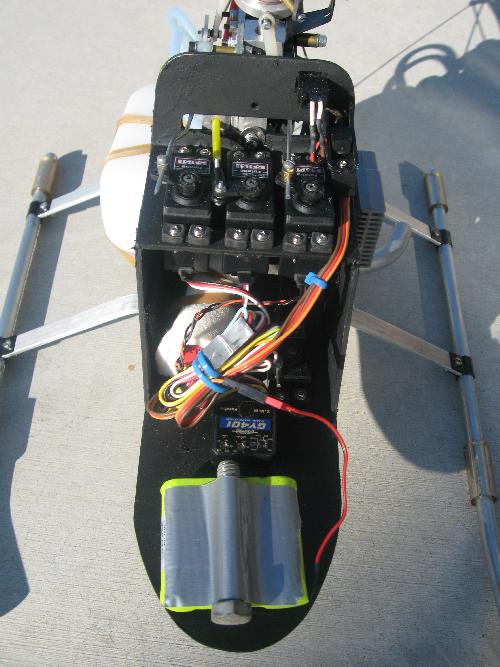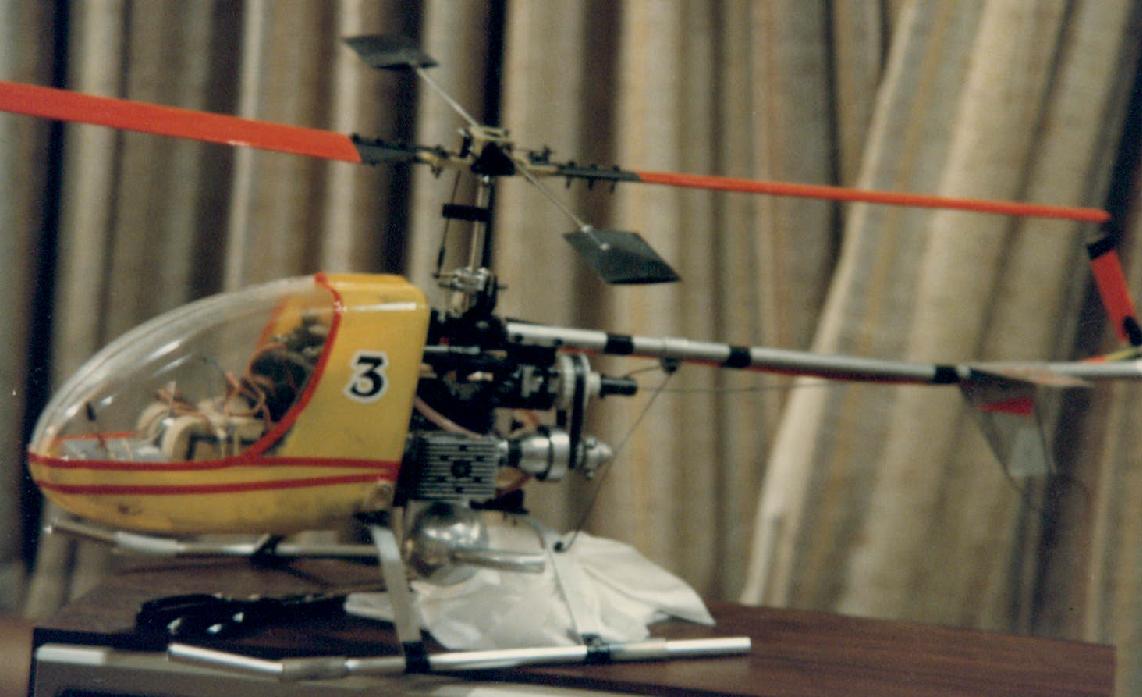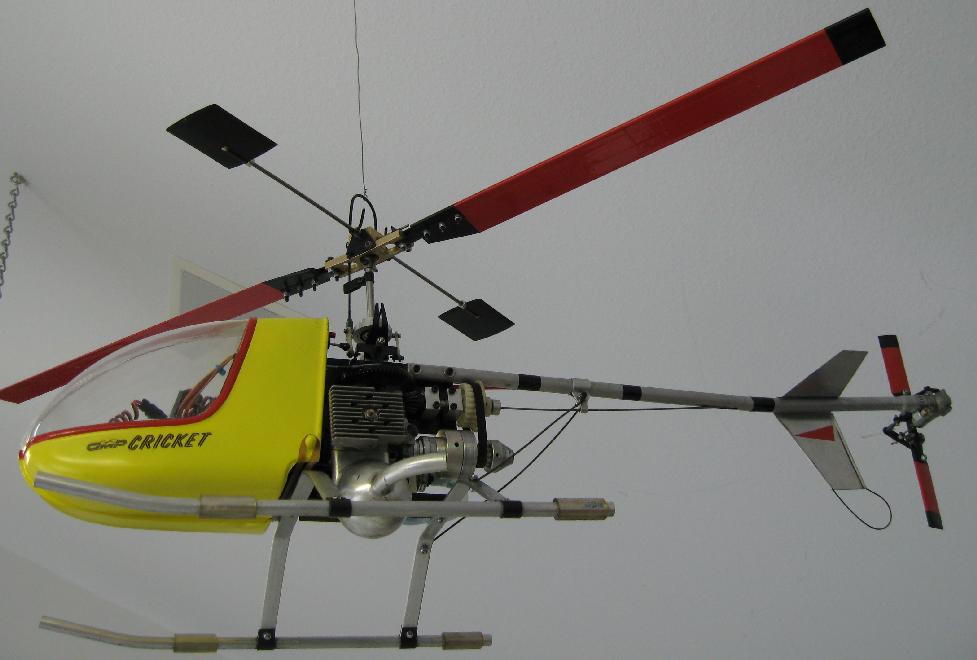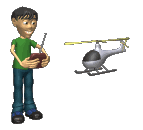
One of John's Gorham's last Crickets. Owned and restored by his son Robert.
Photo courtesy of Robert Gorham, 2017
Being an extremely simple fixed-pitch
helicopter intended as a reliable beginnerís training model, the Cricket
arrived in a neatly organized shipping
box, with a very comprehensive
instruction manual, setup and trim instructions, plus ongoing update bulletins sent
to existing owners.
excerpt of original GMP promotional video - push play to watch
The Cricket was very good little machine for its day. It was in some ways very similar to the earlier Micro-Mold Lark helicopter (circa 1976):
Design Inspiration for the Cricket: the Micro-Mold Lark
The overriding design mantra of the Cricket was absolute simplicity and light weight. In fact, the Cricket even eschewed an engine-driven cooling fan, because it simply was not necessary, it added weight, and robbed power from the drive train.
Early Cricket Prototype
Although Cricket owners could order extra accessories such as the cooling fan, floats for landing on water, a gyro and training gear, Mr. Gorham's enduring focus to "KISS" - Keep it Simple Stupid (and light) won out over all attempts over the years to "improve" the Cricket's design. Rather than changing the Cricket itself, GMP went on to produce three other variants of this highly successful helicopter: the special Gold "Super Custom" Cricket, a scale version of the full sized Hughes 300 helicopter, and then the Rebel which was essentially a larger version of the Cricket.

new Crickets ready for distribution hanging on the wall of the GMP factory
Perhaps envious of the success enjoyed by GMP, Hirobo, the large Japanese radio control manufacturer soon produced a competing model called the Ministar, which was essentially a copy of the Cricket but with a more advanced rotor head design featuring Bell-Hiller mixing:
Hirobo's take on the Cricket: the Ministar
It is unknown how many Crickets survive
today, much less airworthy examples. Despite the difficulties in obtaining
parts, there are a growing number of modern experienced radio control
helicopter pilots who either actually fly a Cricket today
or keep a one on display in their shop, either out of a sense of nostalgia, or
perhaps from a desire for a simpler back-to basics design.
a
GMP Cricket takes to the skies in 2007 - push play to watch
There are even a few very dedicated
enthusiasts who trade original parts and also manufacture and sell
reproduction parts for the Cricket today on the internet. Although these models
are enjoying a resurgence in popularity, GMP Crickets are candidly not the best
beginner helicopter to learn on today. Model helicopter technology has greatly
improved since the 1980's, plus Cricket
parts are fairly hard to come by these days. Crickets
are great fun, and with an experienced pilot, can even perform loops
and rolls! With the manufacture of
reproduction parts, such as
reproduction canopies and the
sharing of helpful hints and
information regarding these historically important collector's models, the GMP
Cricket is gaining popularity with modern experienced R/C helicopter pilots
returning to the "First Love" found again!
Flying a Cricket 25 Years Later
It is early 2007, some 25+ years after the
introduction of the Cricket. We just had to have a go and try to fly one of
these intriguing little helicopters once again to compare it with modern
offerings. Unfortunately, these helicopters have not been sold since 1990.
Parts today are extremely rare and hard to come by. Most Crickets that are
still intact today are hanging from hobby shop ceilings. After a few
months, we had acquired two (almost) complete Crickets, plus a good supply of
spare parts. To my surprise, one of the boxes of miscellaneous Cricket parts
that arrived at my doorstep even included the mythical .28 sized Mac's HeloBall
Muffler! Not only that but thankfully, there is a fellow selling brand-new,
reproduction Cricket canopieson the internet! What's more using the
internet, we also found a very rare, original, never run O.S. Max .28 F-H helicopter
engine. We even found an un-filled GMP Cricket registration card for Cricket kit # 11020,
which will be our claimed "chassis" number for this project! What a
world we live in today!
The build took longer than expected (maybe
about a week of spare time in the evenings) because we had to disassemble
everything and pick the best parts out of the whole lot. We not only had to use
a lot of de-greasing solvents to clean many of the old parts up, but we also
had to do some light polishing to bring back that factory new shine. The original
CNC aluminum components are beautiful, and look great once restored! We
stripped off the old main rotor blade covering, re-painted the blade roots and
tips, then applied a new covering of trim MonoKote before doing a precision
two-way balance of the rotor blades. We completely disassembled two tail rotor
gearboxes and put one together from the best components after de-greasing and
re-packing with mobil-1 synthetic grease. Every nut and bolt checked, and
torqued with blue loctite to help prevent
loosening from the severe vibration that was sure to occur in flight. Out of a
bit of additional caution, we bought some new piano wire from the local hobby
store for the tail drive shaft, and a new drive belt from McMaster-Carr. Continuing
the same theme of keeping the bird original, yet more importantly, reliable and
flyable, we did not want to trust a 25+ year old radio control system, so
instead we opted for a Spektrum
DX7 radio, Futaba
GY401 gyro, and modern digital servos, all state of the art (at
least in 2007):

Interestingly, all of these electronics are
so much lighter than what was available in 1982, that we had to duct tape a
large steel bolt to the battery pack for ballast so that the heli would not be
tail heavy! In GMP's defense however, the Cricket instruction manual does say
that some ballast will be needed up in the nose because the Cricket was
designed so that you could install a little pilot figure there in the cockpit!
The real reason is that the tail rotor gearbox is quite heavy, containing solid
steel internals, and a two-part cast casing. It is a very nicely made piece
however. Too expensive to mass-produce today we suspect. So many of today's
modern helicopters rely on plastic pieces for these critical components. In any
case, we got everything all finished, charged up the batteries, and packed up
for the local expert flyer's house to get the Cricket "maidened" and
trimmed out. After some initial trials and errors getting the engine started,
then some more work tracking the main blades by taking a crescent wrench to the
blade grips and bending up or down slightly to add or reduce pitch on that
blade, we finally had liftoff!
Wow!
25 years old (or just a few days old, depending on how you want to look at it),
and she flies!

April Cricket Update
OK,
well, we bought a bunch more Cricket parts off the internet (why is it that we
can't stop this strange sickness??). Anyway, one of the lots included some of
the major components of the "Super Cricket" that has the gold
anodized rotor head, and black anodized frame. As it turns out, the Gold rotor
head actually is a better design (slightly) than the regular aluminum head. See
our hints page for
details. So, of course, what did we do??? Well, naturally, we built
another Cricket! When will this madness end!!!!????!
You
might notice that besides the gold rotor head, and black anodized frame, this
new "version 2" Cricket Connection Cricket has a slightly different
paint scheme, and red rotor blades instead of the usual white or black blades.
This is because we built this one of look like the old Cricket we had "back
in the day". Take a look at this vintage 1980's picture of the original:

Guess
we were not too good with striping tape and canopy paint back then. Rather than
repeating that particular nightmare, we painted our new V2 canopy in the
standard "yellow and red trim" scheme of the GMP factory-built
Crickets. Anyway, we are having good luck flying the new V2 cricket with the modern
radio equipment that we had originally installed and flew in the V1 Cricket. We
are probably going to be selling the V1 Cricket flying in the video above
shortly, as well as the remaining parts inventory that we reasonably cant see a
need for anytime in the near future, as V2 Cricket will be going up on the
ceiling soon (we will still fly it every one and again).
So.....you may be wondering, after all of
this work and effort, how does the Cricket actually fly? Well, she does
OK. She does not suffer from a lack of power as was originally expected. The
originally spec'ed .28 has enough power to get you out of trouble with room to
spare if you find your descent is too fast. There is really no need to go with
a modern .30 or .32 as has been suggested recently by another Cricket
enthusiast. With the modern heading hold gyro, the tail keeps pretty well
behaved, but not as "locked in" as modern helis of today. What really
keeps you awake is the constant cyclic wondering, and overall lack of
stability. So much of the pilot's effort is used up in just trying to keep the
Cricket in one place. Even with the most modern radio and servos, there is a
noticeable delay between your input at the sticks, and when the model actually
moves. This is not to say the Cricket is not a fun model to fly. Quite the
contrary, all this work makes her a bit more of a challenge, and requires that
much more concentration to fly, making just basic flight more rewarding in a
sense than modern helicopters.
Click on the Play button to watch the Cricket fly!
She is all cleaned up now, and hanging from the
ceiling in a completely ready to fly state.

We will keep her in the air and maybe fly a a few
times a year to keep the cobwebs out!
Next project is the awesome GMP Competitor! Click Here to take a look!
![]()
GMP Cricket Resources
Original Setup & Trim Instructions
Contemporary
Setup & Trim Instructions
GMP Cricket
Product Registration Card
Make your Own
Reproduction Canopy Stickers
Make your Own Reproduction Wooden
Parts
GMP Generic Helicopter Sticker Sheet
Prototype Collective Pitch Cricket?
this website created in consultation with
the late John A. Gorham and the Gorham Estate
You will need the free Adobe Reader
to view and print all GMP Documents
Connect with GMP on Facebook
